Meat Quality, Fatty Acid Content and NMR Metabolic Profile of Dorper Sheep Supplemented with Bypass Fats
Abstract
:1. Introduction
2. Materials and Methods
2.1. Animals, Housing and Treatments
2.2. Chemical Analysis
2.3. Slaughtering and Tissue Sampling
2.4. Aging of Meat
2.5. pH Determination of Muscles
2.6. Determination of Meat Colour Coordinates
2.7. Determination of Water-Holding Capacity (WHC)
2.7.1. Drip Loss
- W1 = Initial weight of the sample
- W2 = Weight after the storage period.
2.7.2. Cooking Loss
- W1 = Initial weight of the sample
- W2 = Weight of cooked sample.
2.8. Texture Analysis
2.9. Analysis of Fatty Acids
2.10. Extraction of Tissue Metabolites and Preparation for NMR Spectroscopy
2.11. NMR Measurement and Data Processing
2.12. Statistical Analysis
3. Results
3.1. Meat Quality
3.2. Colour Coordinates of LD Muscle in Dorper Sheep
3.3. Fatty Acid Composition of LD Muscle in Dorper Sheep
3.4. Fatty Acid Composition of the Liver in Dorper Sheep
3.5. 1H NMR Analyses
3.5.1. 1H NMR Analyses of Polar and Nonpolar Metabolites Excreted from Muscle of Dorper Sheep
3.5.2. 1H NMR Analyses of Polar and Nonpolar Metabolites Excreted from the Liver of Dorper Sheep
3.5.3. Principal Component Analysis (PCA) of NMR Data of Muscle Tissue
3.5.4. Principal Component Analysis (PCA) of NMR Data of Liver Tissue
4. Discussion
5. Conclusions
Supplementary Materials
Author Contributions
Funding
Institutional Review Board Statement
Informed Consent Statement
Data Availability Statement
Acknowledgments
Conflicts of Interest
References
- McAfee, A.J.; McSorley, E.M.; Cuskelly, G.J.; Moss, B.W.; Wallace, J.M.; Bonham, M.P.; Fearon, A.M. Red meat consumption: An overview of the risks and benefits. Meat Sci. 2010, 84, 1–13. [Google Scholar] [CrossRef] [PubMed]
- Mann, N. Dietary lean red meat and human evolution. Eur. J. Nutr. 2000, 39, 71–79. [Google Scholar] [CrossRef] [PubMed]
- Siddiqui, R.A.; Harvey, K.A.; Zaloga, G.P. Modulation of enzymatic activities by n-3 polyunsaturated fatty acids to support cardiovascular health. J. Nutr. Biochem. 2008, 19, 417–437. [Google Scholar] [CrossRef] [PubMed]
- Warner, C.M.; Hahm, S.W.; Archibeque, S.L.; Wagner, J.J.; Engle, T.E.; Roman-Muniz, I.N.; Woerner, D.; Sponsler, M.; Han, H. A comparison of supplemental calcium soap of palm fatty acids versus tallow in a corn-based finishing diet for feedlot steers. J. Anim. Sci. Technol. 2015, 57, 1–7. [Google Scholar] [CrossRef] [Green Version]
- Ekeren, P.A.; Smith, D.R.; Lunt, D.K.; Smith, S.B. Ruminal biohydrogenation of fatty acids from high-oleate sunflower seeds. J. Anim. Sci. 1992, 70, 2574–2580. [Google Scholar] [CrossRef]
- St John, L.C.; Young, C.R.; Knabe, A.D.; Smith, S.B. FA profiles and sensory and carcass traits of tissues from steers and swine fed an elevated monosaturated fat diet. J. Anim. Sci. 1987, 64, 1441–1447. [Google Scholar] [CrossRef] [Green Version]
- Purushothaman, S.; Kumar, A.; Tiwari, D.P. Effect of feeding calcium salts of palm oil fatty acids on performance of lactating crossbred cows. Asian Austral. J. Anim. Sci. 2008, 21, 376. [Google Scholar] [CrossRef]
- Wood, J.D.; Enser, M.; Fisher, A.V.; Nute, G.R.; Sheard, P.R.; Richardson, R.I.; Hughed, S.I.; Whittington, F.M. Fat deposition, fatty acid composition and meat quality: A review. Meat Sci. 2008, 78, 343–358. [Google Scholar] [CrossRef] [PubMed]
- Schmid, A.; Collomb, M.; Sieber, R.; Bee, G. Conjugated linoleic acid in meat and meat products: A review. Meat Sci. 2006, 73, 29–41. [Google Scholar] [CrossRef]
- Wood, J.D.; Richardson, R.I.; Nute, G.R.; Fisher, A.V.; Campo, M.M.; Kasapidou, E.; Sheard, P.R.; Enser, M. Effects of fatty acids on meat quality: A review. Meat Sci. 2004, 66, 21–32. [Google Scholar] [CrossRef]
- Palmquist, D.L.; Jenkins, T.C. Fat in Lactation Rations: Review. J. Dairy Sci. 1980, 63, 1–14. [Google Scholar] [CrossRef]
- Gowda, N.K.S.; Manegar, A.; Raghavendra, A.; Verma, S.; Maya, G.P.A.L.D.T.; Pal, D.T.; Suresh, K.P.; Sampath, K.T. Effect of protected fat supplementation to high yielding dairy cows in field condition. Anim. Nutr. Feed Technol. 2013, 13, 125–130. [Google Scholar]
- Naik, P.K. Bypass fat in dairy ration-a review. Anim. Nutr. Feed Technol. 2013, 147–163. [Google Scholar]
- Shelke, S.K.; Thakur, S.S.; Shete, S.M. Productive and reproductive performance of Murrah buffaloes (Bubalus bubalis) supplemented with rumen protected fat and protein. Indian J. Anim. Nutr. 2012, 29, 317–323. [Google Scholar]
- Wadhwa, M.; Grewal, R.S.; Bakshi, M.P.S.; Brar, P.S. Effect of supplementing bypass fat on the performance of high yielding crossbred cows. Indian J. Anim. Sci. 2012, 82, 200. [Google Scholar]
- Mangrum, K.S.; Tuttle, G.; Duckett, S.K.; Sell, G.S.; Krehbiel, C.R.; Long, N.M. The effect of supplementing rumen undegradable unsaturated fatty acids on marbling in early-weaned steers. J. Anim. Sci. 2016, 94, 833–844. [Google Scholar] [CrossRef] [Green Version]
- Long, N.M.; Burns, T.A.; Duckett, S.K.; Schafer, D.W. Reproductive performance and serum fatty acid profiles of underdeveloped beef heifers supplemented with saturated or unsaturated rumen bypass fat compared to an isocaloric control. Prof. Anim. Sci. 2014, 30, 502–509. [Google Scholar] [CrossRef]
- Hightshoe, R.B.; Cochran, R.C.; Corah, L.R.; Harmon, D.L.; Vanzant, E.S. Influence of source and level of ruminal-escape lipid in supplements on forage intake, digestibility, digesta flow, and fermentation characteristics in beef cattle. J. Anim. Sci. 1991, 69, 4974–4982. [Google Scholar] [CrossRef]
- Olivecrona, N. Investigation of the Confinement Odour Problem in Exported Lamb Using NMR-Based Metabolomics: A Thesis Presented in Partial Fulfillment of the Requirements for the Degree of Master of Science in Chemistry at Massey University, Manawatū, New Zealand. Ph.D. Thesis, Massey University, Manawatū, New Zealand, 2015. retrieved on 23 February 2020. [Google Scholar]
- Muroya, S.; Ueda, S.; Komatsu, T.; Miyakawa, T.; Ertbjerg, P. MEATabolomics: Muscle and meat metabolomics in domestic animals. Metabolites 2020, 10, 188. [Google Scholar] [CrossRef] [PubMed]
- Cônsolo, N.R.B.; Silva, J.D.; Buarque, V.L.M.; Higuera-Padilla, A.; Barbosa, L.C.G.S.; Zawadzki, A.; Colnago, L.A.; Netto, A.S.; Gerrard, D.E.; Silva, S.L. Selection for growth and precocity alters muscle metabolism in nellore cattle. Metabolites 2020, 10, 58. [Google Scholar] [CrossRef] [Green Version]
- Carrillo, J.A.; He, Y.; Li, Y.; Liu, J.; Erdman, R.A.; Sonstegard, T.S.; Song, J. Integrated metabolomic and transcriptome analyses reveal finishing forage affects metabolic pathways related to beef quality and animal welfare. Sci. Rep. 2016, 6, 25948. [Google Scholar] [CrossRef] [PubMed]
- Yu, K.; Matzapetakis, M.; Valent, D.; Saco, Y.; De Almeida, A.M.; Terre, M.; Bassols, A. Skeletal muscle metabolomics and blood biochemistry analysis reveal metabolic changes associated with dietary amino acid supplementation in dairy calves. Sci. Rep. 2018, 8, 13850. [Google Scholar] [CrossRef] [PubMed]
- De Zawadzki, A.; Arrivetti, L.O.R.; Vidal, M.P.; Catai, J.R.; Nassu, R.T.; Tullio, R.R.; Berndt, A.; Oliveira, C.R.; Ferreira, A.G.; Neves-Junior, L.F.; et al. Mate extract as feed additive for improvement of beef quality. Food Res. Int. 2017, 99, 336–347. [Google Scholar] [CrossRef]
- Ritota, M.; Casciani, L.; Failla, S.; Valentini, M. HRMAS-NMR spectroscopy and multivariate analysis meat characterization. Meat Sci. 2012, 92, 754–761. [Google Scholar] [CrossRef]
- Lana, A.; Longo, V.; Dalmasso, A.; D’Alessandro, A.; Bottero, M.T.; Zolla, L. Omics integrating physical techniques: Aged Piedmontese meat analysis. Food Chem. 2015, 172, 731–741. [Google Scholar] [CrossRef]
- Kim, Y.H.B.; Kemp, R.; Samuelsson, L.M. Effects of dry-aging on meat quality attributes and metabolite profiles of beef loins. Meat Sci. 2016, 111, 168–176. [Google Scholar] [CrossRef]
- Yang, Y.; Ye, Y.; Pan, D.; Sun, Y.; Wang, Y.; Cao, J. Metabonomics profiling of marinated meat in soy sauce during processing. J. Sci. Food Agric. 2018, 98, 1325–1331. [Google Scholar] [CrossRef] [PubMed]
- Behan, A.A.; Loh, T.C.; Fakurazi, S.; Kaka, U.; Kaka, A.; Samsudin, A.A. Effects of supplementation of rumen protected fats on rumen ecology and digestibility of nutrients in sheep. Animals 2019, 9, 400. [Google Scholar] [CrossRef] [Green Version]
- National Research Council. Nutrient Requirements of Small Ruminants, 6th ed.; National Academy Press: Washington, DC, USA, 2007; p. 384.
- Adeyemi, K.D.; Sabow, A.B.; Abubakar, A.; Samsudin, A.A.; Sazili, A.Q. Effects of dietary oil blend on fatty acid composition, oxidative stability and physicochemical properties of Longissimus thoracis et lumborum muscle in goats. Anim. Sci. J. 2016, 87, 1421–1432. [Google Scholar] [CrossRef] [PubMed]
- Van Soest, P.J.; Robertson, J.B.; Lewis, B.A. Methods for dietary fiber, neutral detergent fiber, and non-starch polysaccharides in relation to animal nutrition. J. Dairy Sci. 1991, 74, 3583–3597. [Google Scholar] [CrossRef]
- Department of Standards Malaysia. MS1500: 2009 (1st Revision) Halal Food Production, Preparation, Handling and Storage-General Guideline; Department of Standards Malaysia: Cyberjaya, Malaysia, 2009; pp. 1–13.
- Honikel, K.O. Influence of post mortem processes and cooking on water holding capacity and tenderness of meat. In Proceedings of the International Symposium: Trends in Modern Meat Technology 2, Den Dolder, The Netherlands, 23–25 November 1987; Pudoc: Wageningen, The Netherlands, 1988. [Google Scholar]
- Viant, M.R. Revealing the metabolome of animal tissues using 1H nuclear magnetic resonance spectroscopy. In Metabolomics; Methods in Molecular Biology; Weckwerth, W., Ed.; Humana Press: Totowa, NJ, USA, 2007; Volume 358, pp. 229–246. [Google Scholar] [CrossRef]
- Palma, M.; Scanlon, T.; Kilminster, T.; Milton, J.; Oldham, C.; Greeff, J.; Matzapetakis, M.; Almeida, A.M. The hepatic and skeletal muscle ovine metabolomes as affected by weight loss: A study in three sheep breeds using NMR-metabolomics. The hepatic and skeletal muscle ovine metabolomes as affected by weight loss: A study in three sheep breeds using NMR-metabolomics. Sci. Rep. 2016, 6, 39120. [Google Scholar] [CrossRef] [PubMed] [Green Version]
- Eriksson, L.; Johansson, E.; Kettaneh-Wold, N.; Wold, S. Introduction to Multi- and Megavariate Data Analysis Using Projection Methods (PCA & PLS); Umetrics: Umeå, Sweden, 1999; pp. 213–225. [Google Scholar]
- Loo, R.L.; Coen, M.; Ebbels, T.; Cloarec, O.; Maibaum, E.; Bictash, M.; Yap, I.; Elliott, P.; Stamler, J.; Nicholson, J.K.; et al. Metabolic profiling and population screening of analgesic usage in nuclear magnetic resonance spectroscopy-based large-scale epidemiologic studies. Anal. Chem. 2009, 81, 5119–5129. [Google Scholar] [CrossRef] [Green Version]
- Salwani, M.S.; Adeyemi, K.D.; Sarah, S.A.; Vejayan, J.; Zulkifli, I.; Sazili, A.Q. Skeletal muscle proteome and meat quality of broiler chickens subjected to gas stunning prior slaughter or slaughtered without stunning. CyTA. J Food 2015, 14, 375–381. [Google Scholar] [CrossRef] [Green Version]
- Andersen, J.R.; Borggaard, C.; Rasmussen, A.J.; Houmøller, L.P. Optical measurements of pH in meat. Meat Sci. 1999, 53, 135–141. [Google Scholar] [CrossRef] [Green Version]
- Lawrie, R.; Ledward, D. Lawrie’s Meat Science; Woodhead Publishing Ltd.: Cambridge, UK, 2006. [Google Scholar]
- Adeyemi, K.D.; Sazili, A.Q. Efficacy of carcass electrical stimulation in meat quality enhancement: A review. Asian Austral. J. Anim. Sci. 2014, 27, 447–456. [Google Scholar] [CrossRef] [PubMed] [Green Version]
- Harris, R. Carbohydrate metabolism I: Major metabolic pathways and their control. In Textbook of Biochemistry with Clinical Correlations; John Wiley & Sons: Hoboken, NJ, USA, 1992; pp. 291–358. [Google Scholar]
- Greaser, M. Conversion of muscle to meat. In Muscle as Food; Academic Press: Cambridge, MA, USA, 1986; pp. 37–102. [Google Scholar]
- Sutter, F.; Casutt, M.M.; Ossowski, D.A.; Scheeder, M.R.L.; Kreuzer, M. Comparative evaluation of rumen-protected fat, coconut oil and various oilseeds supplemented to fattening bulls: Effects on growth, carcass and meat quality. Arch. Anim. Nutr. 2000, 53, 1–23. [Google Scholar] [CrossRef] [PubMed]
- Awawdeh, M.S.; Obeidat, B.S.; Abdullah, A.Y.; Hananeh, W.M. Effects of yellow grease or soybean oil on performance, nutrient digestibility and carcass characteristics of finishing Awassi lambs. Anim. Feed Sci. Technol. 2009, 153, 216–227. [Google Scholar] [CrossRef]
- Rizzi, L.; Simioli, M.; Sardi, L.; Monetti, P.G. Carcass quality, meat chemical and fatty acid composition of lambs fed diets containing extruded soybeans and sunflower seeds. Anim. Feed Sci. Technol. 2002, 97, 103–114. [Google Scholar] [CrossRef]
- Rozanski, S.; Vivian, D.R.; Kowalski, L.H.; Prado, O.R.; Fernandes, S.R.; de Souza, J.C.; de Freitas, J.A. Carcass and meat traits and non-carcass components of lambs fed ration containing increasing levels of urea. Semin. Ciênc. Agrár. 2017, 38, 1577–1594. [Google Scholar] [CrossRef]
- Oliveira, E.A.; Sampaio, A.A.M.; Henrique, W.; Pivaro, T.M.; Rosa, B.L.; Fernandes, A.R.M.; Andrade, A.T. Quality traits and lipid composition of meat from Nellore young bulls fed with different oils either protected or unprotected from rumen degradation. Meat Sci. 2012, 90, 28–35. [Google Scholar] [CrossRef] [Green Version]
- Warriss, P.D. Meat Science: An Introductory Text, 2nd ed.; Cambridge CABI Publishing: Wallingford, UK, 2010. [Google Scholar]
- Hamm, R. Functional Properties of the Myofibrillar System and Their Measurements; Academic Press: Cambridge, MA, USA, 1986; pp. 135–199. ISBN 01-208-41908. [Google Scholar]
- Aghwan, Z.A.A. Effects of Iodine and Selenium Supplementation on Growth, Carcass Characteristics and Meat Quality of Crossbred Kacang Goats. Ph.D. Thesis, Universiti Putra Malaysia, Seri Kembangan, Malaysia, 2013. [Google Scholar]
- Offer, G.; Trinick, J. On the mechanism of water holding in meat: The swelling and shrinking of myofibrils. Meat Sci. 1983, 8, 245–281. [Google Scholar] [CrossRef]
- Offer, G. The structural basis of water-holding in meat. Dev. Meat Sci. 1988, 4, 63. [Google Scholar]
- Bruce, H.; Stark, J.; Beilken, S. The effect of finishing diet and post mortem ageing on the quality of M. longissimus thoracis of the electrically stimulated Brahman steer carcasses. Meat Sci. 2004, 67, 261–268. [Google Scholar] [CrossRef]
- Bhatt, R.S.; Sahoo, A.; Karim, S.A.; Gadekar, Y.P. Effects of Saccharomyces cerevisiae and rumen bypass-fat supplementation on growth, nutrient utilisation, rumen fermentation and carcass traits of lambs. Anim. Prod. Sci. 2016, 58, 530–538. [Google Scholar] [CrossRef]
- Andrade, E.N.D.; Neto, A.P.; Roça, R.D.O.; Faria, M.D.; Resende, F.D.; Siqueira, G.R.; Pinheiro, R.S.B. Beef quality of young Angus x Nellore cattle supplemented with rumen-protected lipids during rearing and fatting periods. Meat Sci. 2014, 98, 591–598. [Google Scholar] [CrossRef]
- Bhatt, R.S.; Soren, N.M.; Tripathi, M.K.; Karim, S.A. Effects of different levels of coconut oil supplementation on performance, digestibility, rumen fermentation and carcass traits of Malpura lambs. Anim. Feed Sci. Technol. 2011, 164, 29–37. [Google Scholar] [CrossRef]
- Gilbert, C.D.; Lunt, D.K.; Miller, R.K.; Smith, S.B. Carcass, sensory, and adipose tissue traits of Brangus steers fed casein-formaldehyde-protected starch and/or canola lipid. J. Anim. Sci. 2003, 81, 2457–2468. [Google Scholar] [CrossRef]
- Lima, E.S.; de Morais, J.P.G.; de Oliveira Roça, R.; de Andrade, E.N.; Valente, T.N.P.; da Costa, Q.P.B.; Deminicis, B.B. Effect of different sources of lipids in diet on the qualitative characteristics of Longissimus thoracis muscle of cattle finished in feedlots. Afr. J. Agric. Res. 2015, 10, 2835–2840. [Google Scholar] [CrossRef] [Green Version]
- Aferri, G.; Leme, P.R.; Silva, S.D.L.; Putrino, S.M.; Pereira, A.S.C. Performance and carcass characteristics of steers fed different fat sources. Rev. Bras. Zootec. 2005, 34, 1651–1658. [Google Scholar] [CrossRef] [Green Version]
- Lima, E.S.; Valente, T.N.P.; de Oliveira Roça, R.; Cezário, A.S.; dos Santos, W.B.R.; Deminicis, B.B.; Ribeiro, J.C. Effect of whole cottonseed or protected fat dietary additives on carcass characteristics and meat quality of beef cattle: A review. J. Agric. Sci. 2017, 9, 175. [Google Scholar] [CrossRef]
- Bhatt, R.S.; Karim, S.A.; Sahoo, A.; Shinde, A.K. Growth performance of lambs fed diet supplemented with rice bran oil as such or as calcium soap. Asian Austral. J. Anim. Sci. 2013, 26, 812–819. [Google Scholar] [CrossRef] [PubMed]
- Costa, D.P.B.D.; Roça, R.D.O.; Costa, Q.P.B.D.; Lanna, D.P.D.; Lima, E.D.S.; Barros, W.M.D. Meat characteristics of Nellore steers fed whole cottonseed. Rev. Bras. Zootec. 2013, 42, 183–192. [Google Scholar] [CrossRef] [Green Version]
- Busboom, J.R.; Miller, G.J.; Field, R.A.; Crouse, J.D.; Riley, M.L.; Nelms, G.E.; Ferrell, C.L. Characteristics of fat from heavy ram and wether lambs. J. Anim. Sci. 1981, 52, 83–92. [Google Scholar] [CrossRef] [Green Version]
- Sazili, A.Q.; Abdul Rahim, A.H.; Hilmi, M. A study on the effects of conditioning on shear force values and water holding capacity of different skeletal muscles in Malaysian indigenous (Malin) sheep. In Proceedings of the 54th International Congress of Meat Science & Technology, Cape Town, South Africa, 10–15 August 2008. [Google Scholar]
- Sabow, A.B.; Sazili, A.Q.; Zulkifli, I.; Goh, Y.M.; Kadir, M.Z.A.A.; Adeyemi, K.D. Physico-chemical characteristics of Longissimus lumborum muscle in goats subjected to halal slaughter and anaesthesia (halothane) pre-slaughter. Anim. Sci. J. 2015, 86, 981–991. [Google Scholar] [CrossRef] [PubMed]
- Ghani, A.A.A.; Rusli, N.D.; Shahudin, M.S.; Goh, Y.M.; Zamri-Saad, M.; Hafandi, A.; Hassim, H.A. Utilisation of oil palm fronds as ruminant feed and its effect on fatty acid metabolism. Pertanika J. Trop. Agric. Sci. 2017, 40, 215–224. [Google Scholar]
- Watkins, S.M.; German, J.B. Omega Fatty Acids. In Food Lipids: Chemistry, Nutrition and Biotechnology; Akoh, C.C., Min, D.B., Eds.; Marcel Dekker Inc.: New York, NY, USA, 1998; pp. 463–493. [Google Scholar]
- Adeyemi, K.D.; Ebrahimi, M.; Samsudin, A.A.; Sabow, A.B.; Sazili, A.Q. Carcass traits, meat yield and fatty acid composition of adipose tissues and Supraspinatus muscle in goats fed blend of canola oil and palm oil. J. Anim. Sci. Technol. 2015, 57, 42. [Google Scholar] [CrossRef] [Green Version]
- Ebrahimi, M.; Rajion, M.A.; Goh, Y.M. Effects of oils rich in linoleic and α-linolenic acids on fatty acid profile and gene expression in goat meat. Nutrients 2014, 6, 3913–3928. [Google Scholar] [CrossRef] [Green Version]
- Kim, S.C.; Adesogan, A.T.; Badinga, L.; Staples, C.R. Effects of dietary n-6: N-3 fatty acid ratio on feed intake, digestibility, and fatty acid profiles of the ruminal contents, liver, and muscle of growing lambs. J. Anim. Sci. 2007, 85, 706–716. [Google Scholar] [CrossRef] [Green Version]
- Roy, A.; Mandal, G.P.; Patra, A.K. Evaluating the performance, carcass traits and conjugated linoleic acid content in muscle and adipose tissues of Black Bengal goats fed soybean oil and sunflower oil. Anim. Feed Sci. Technol. 2013, 185, 43–52. [Google Scholar] [CrossRef]
- Ferreira, E.M.; Pires, A.V.; Susin, I.; Gentil, R.S.; Parente, M.O.M.; Nolli, C.P.; Meneghini, R.C.M.; Mendes, C.Q.; Ribeiro, C.V.D.M. Growth, feed intake, carcass characteristics, and meat fatty acid profile of lambs fed soybean oil partially replaced by fish oil blend. Anim. Feed Sci. Technol. 2014, 187, 9–18. [Google Scholar] [CrossRef] [Green Version]
- Li, X.Z.; Park, B.K.; Hong, B.C.; Ahn, J.S.; Shin, J.S. Effect of soy lecithin on total cholesterol content, fatty acid composition and carcass characteristics in the Longissimus dorsi of Hanwoo steers (Korean native cattle). Anim. Sci. J. 2017, 88, 847–853. [Google Scholar] [CrossRef] [PubMed]
- Barendse, W. Should animal fats be back on the table? A critical review of the human health effects of animal fat. Anim. Prod. Sci. 2014, 54, 831–855. [Google Scholar] [CrossRef] [Green Version]
- Parvar, R.; Ghoorchi, T.; Shargh, M.S. Influence of dietary oils on performance, blood metabolites, purine derivatives, cellulase activity and muscle fatty acid composition in fattening lambs. Small Rumin. Res. 2017, 150, 22–29. [Google Scholar] [CrossRef]
- Jaworska, D.; Czauderna, M.; Przybylski, W.; Rozbicka-Wieczorek, A.J. Sensory quality and chemical composition of meat from lambs fed diets enriched with fish and rapeseed oils, carnosic acid and seleno-compounds. Meat Sci. 2016, 119, 185–192. [Google Scholar] [CrossRef] [PubMed]
- Gómez, I.; Mendizabal, J.A.; Sarriés, M.V.; Insausti, K.; Albertí, P.; Realini, C.; Pérez-Juan, M.; Oliver, M.A.; Purroy, A.; Beriain, M.J. Fatty acid composition of young Holstein bulls fed whole linseed and rumen-protected conjugated linoleic acid-enriched diets. Livest. Sci. 2015, 180, 106–112. [Google Scholar] [CrossRef]
- Scollan, N.D.; Enser, M.; Gulati, S.K.; Richardson, I.; Wood, J.D. Effects of including a ruminally protected lipid supplement in the diet on the fatty acid composition of beef muscle. Br. J. Nutr. 2003, 90, 709–716. [Google Scholar] [CrossRef] [PubMed]
- Jeong, J.Y.; Kim, M.; Ji, S.Y.; Baek, Y.C.; Lee, S.; Oh, Y.K.; Reddy, K.S.; Seo, H.W.; Cho, S.; Lee, H.J. Metabolomics Analysis of the Beef Samples with Different Meat Qualities and Tastes. Food Sci. Anim. Resour. 2020, 40, 924. [Google Scholar] [CrossRef]
- Zeisel, S.H.; Blusztajn, J.K. Choline and human nutrition. Annu. Rev. Nutr. 1994, 14, 269–271. [Google Scholar] [CrossRef]
- Pratiwi, N.W.; Murray, P.J.; Taylor, D.G. Total cholesterol concentrations of the muscles in castrated Boer goats. Small Rum. Res. 2006, 64, 77–81. [Google Scholar] [CrossRef]
- Adriani, L.; Hernawan, E.; Hidayat, U. Role of sweet orange (Citrus sinensis) waste in lowering the meat cholesterol and fat of Padjadjaran sheep. J. Ilmu Ternak Vet. 2016, 20, 250–256. [Google Scholar] [CrossRef]
- Jimenez-Colmenero, F.; Carballo, J.; Cofrades, S. Healthier meat and meat products: Their role as functional foods. Meat Sci. 2001, 59, 5–13. [Google Scholar] [CrossRef]
- Degen, A.A.; Kam, M. Body mass loss and body fluid shifts during dehydration in Dorper sheep. J. Agric. Sci. 1992, 119, 419–422. [Google Scholar] [CrossRef]
- Ocak, S.; Ogun, S.; Yilmaz, O. Dorper sheep utilizing feed resources efficiently: A Mediterranean case study. Rev. Bras. Zootec. 2016, 45, 489–498. [Google Scholar] [CrossRef] [Green Version]
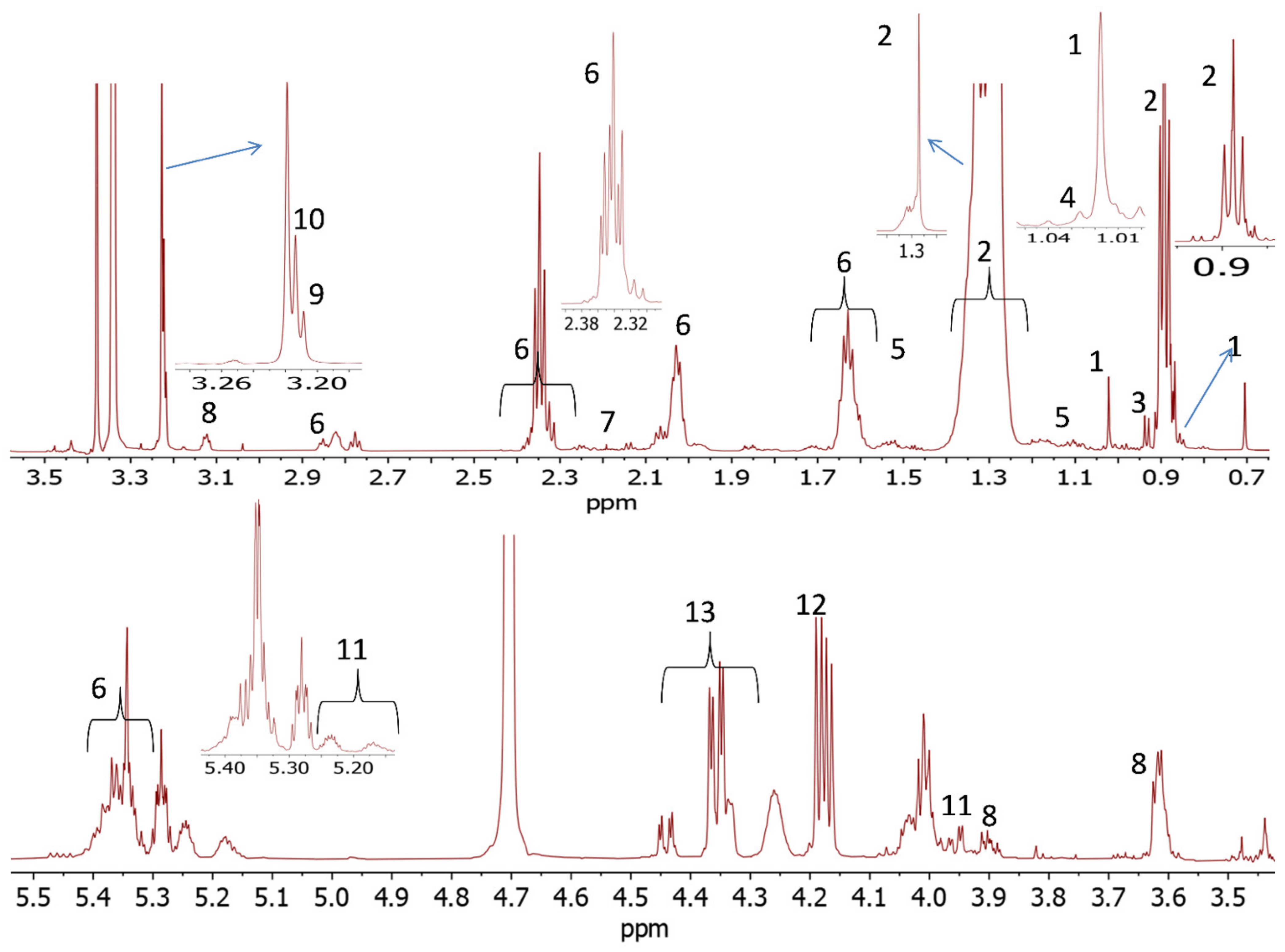

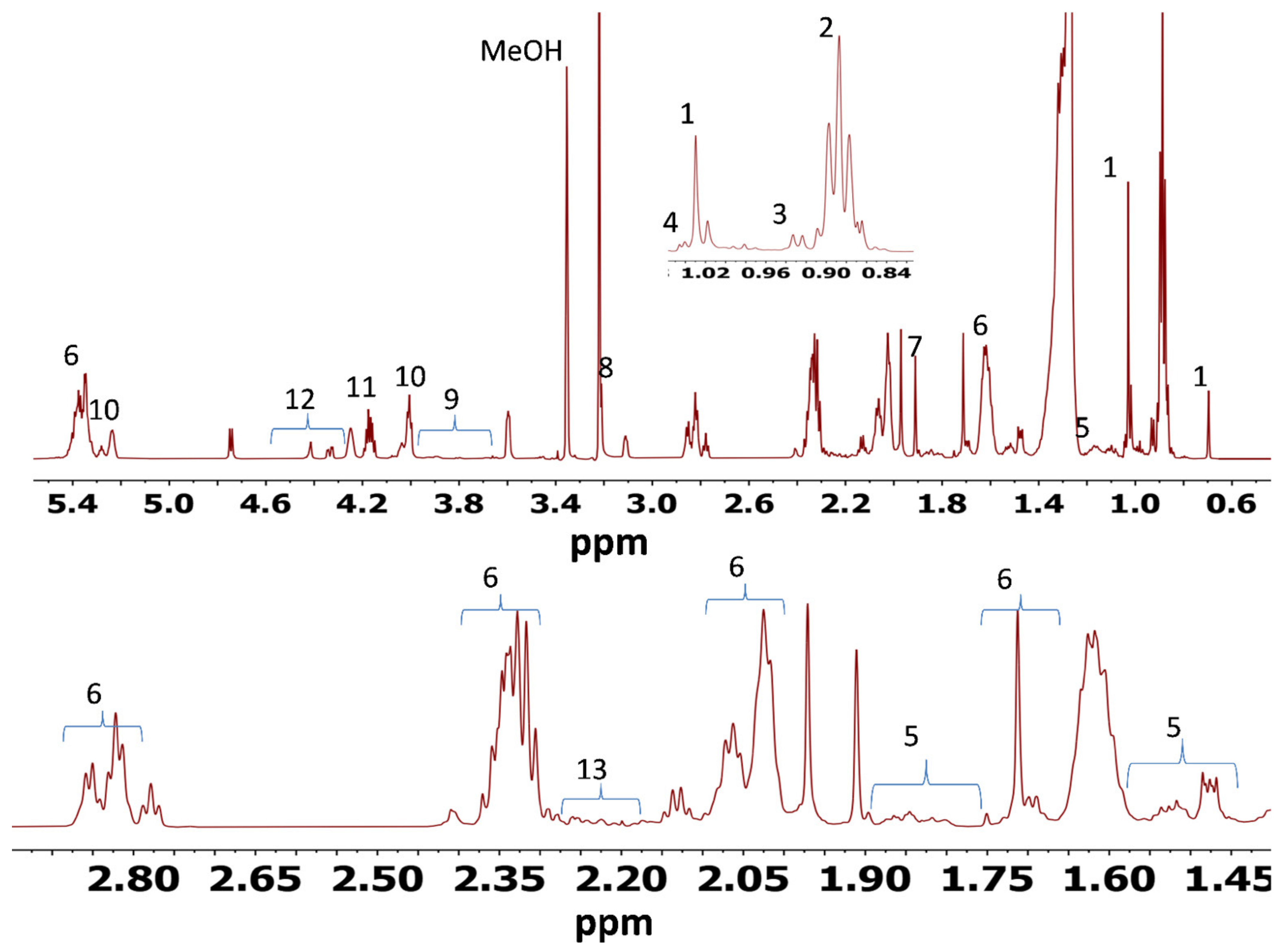
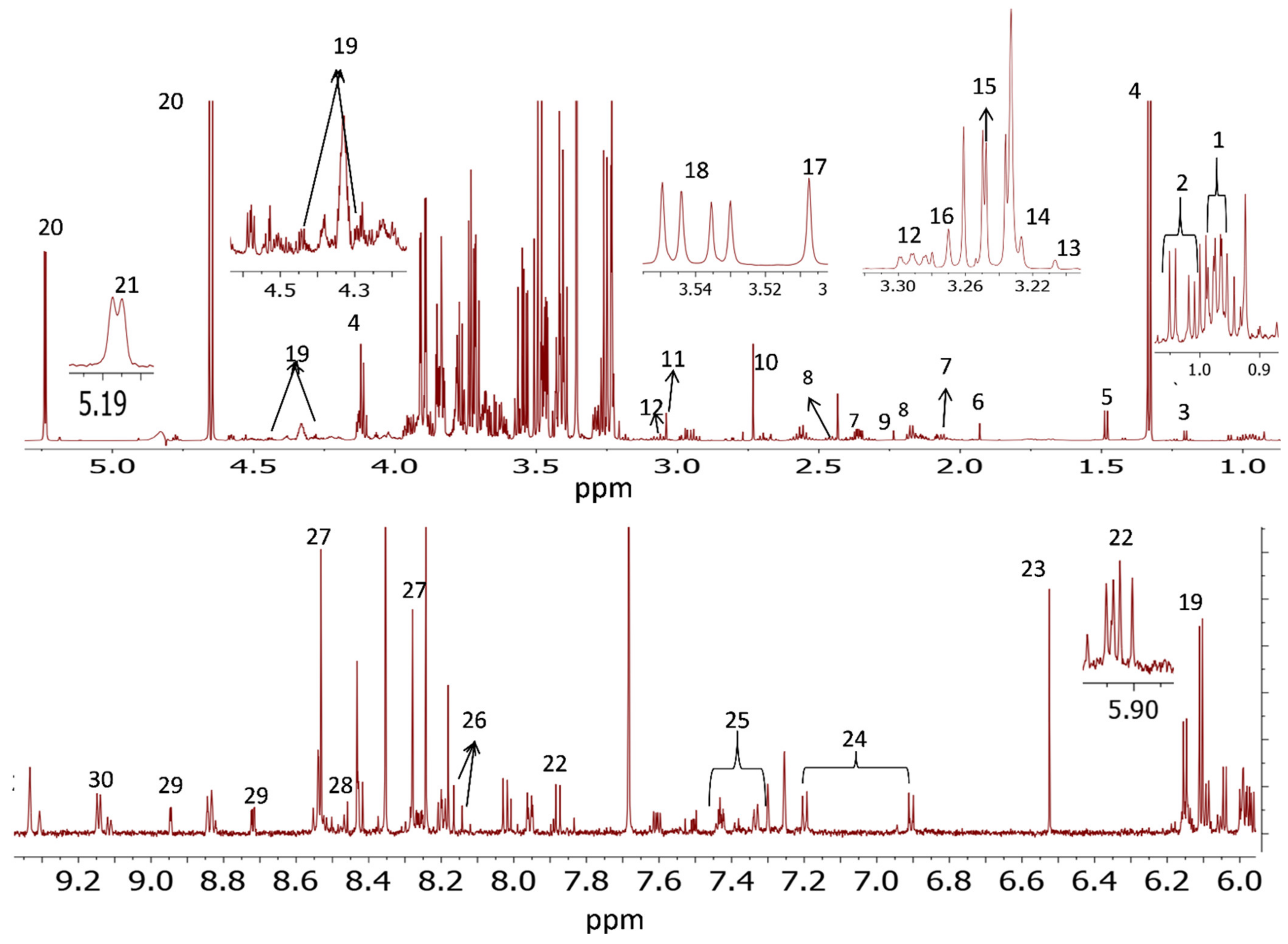
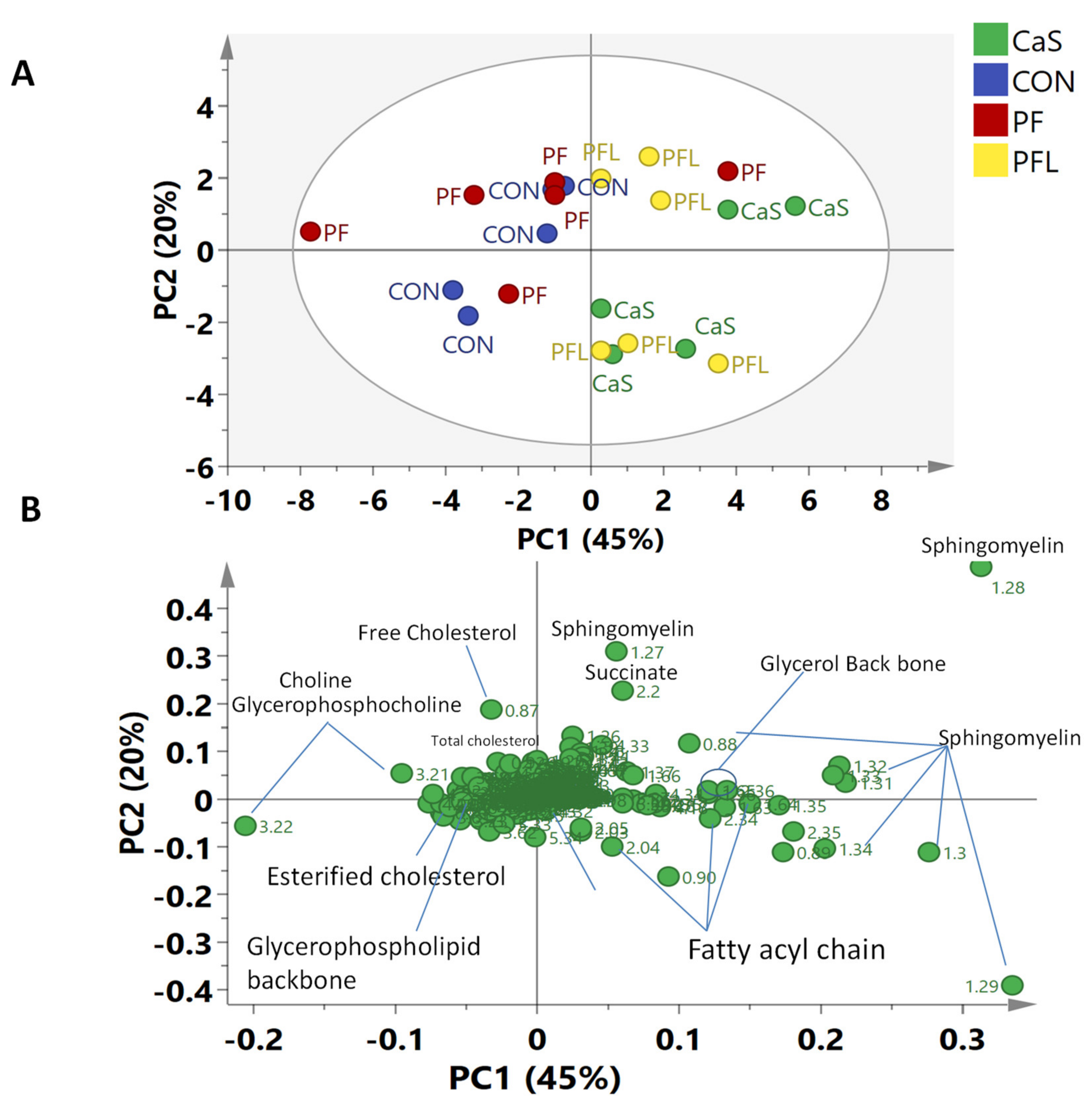
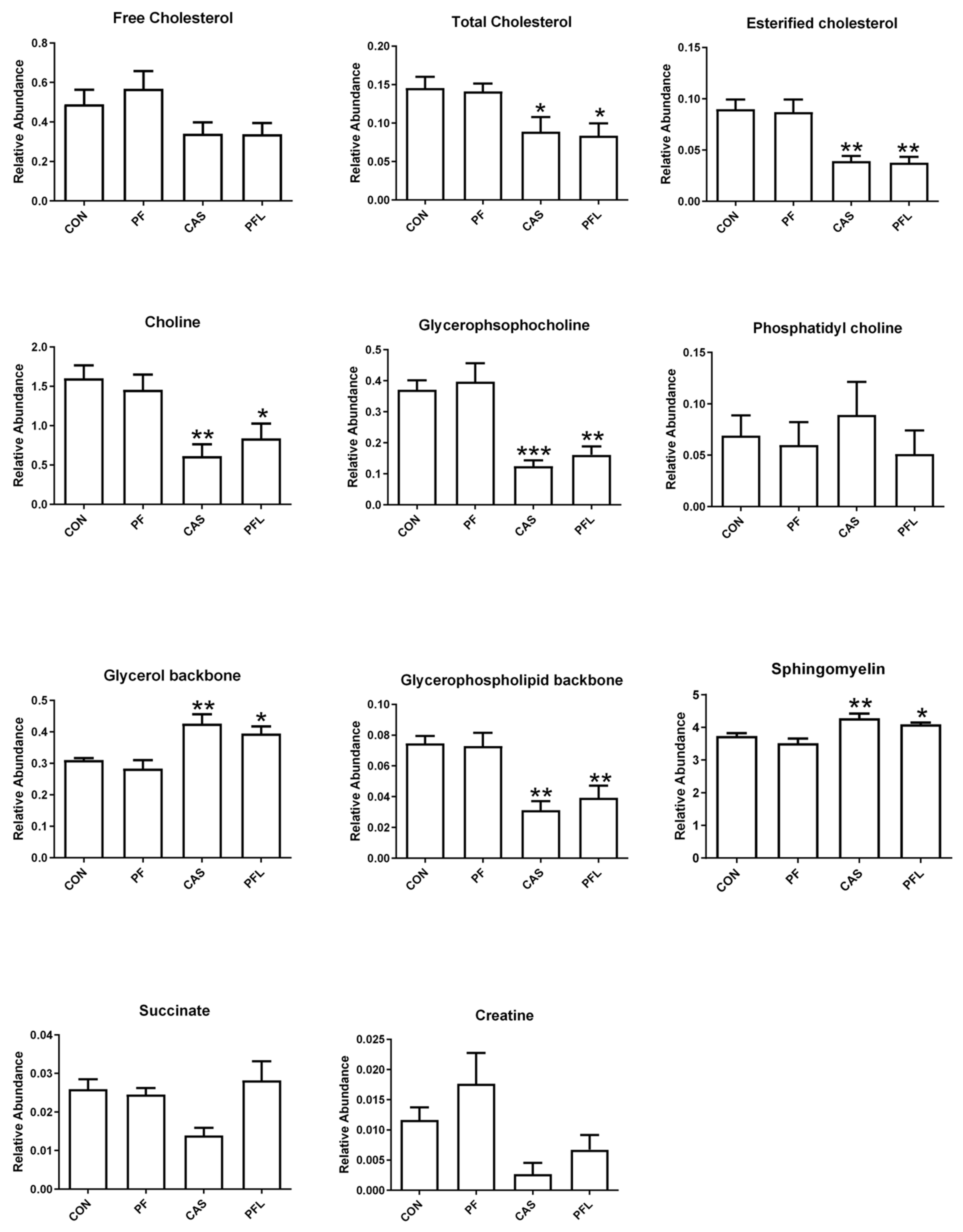
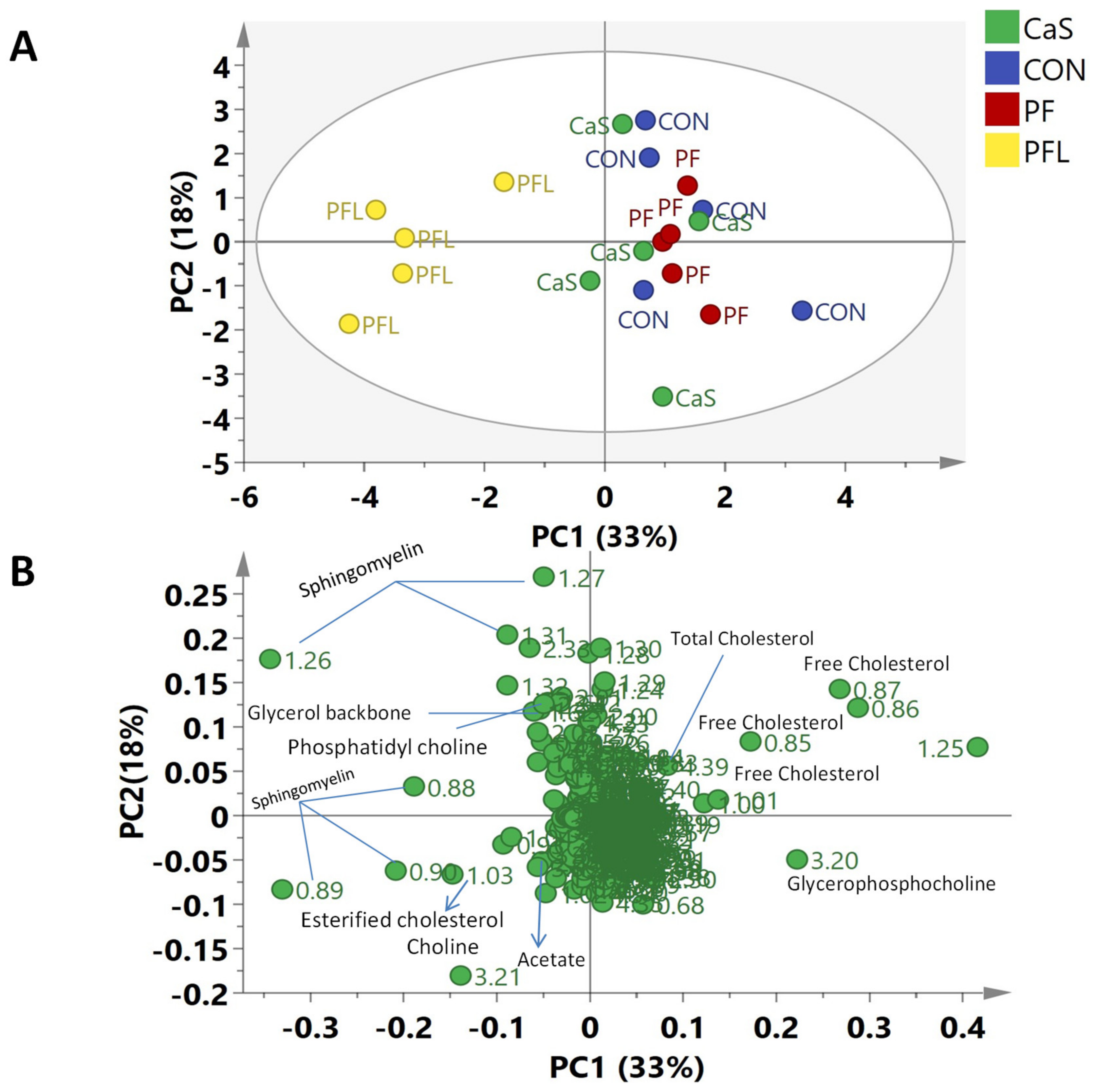
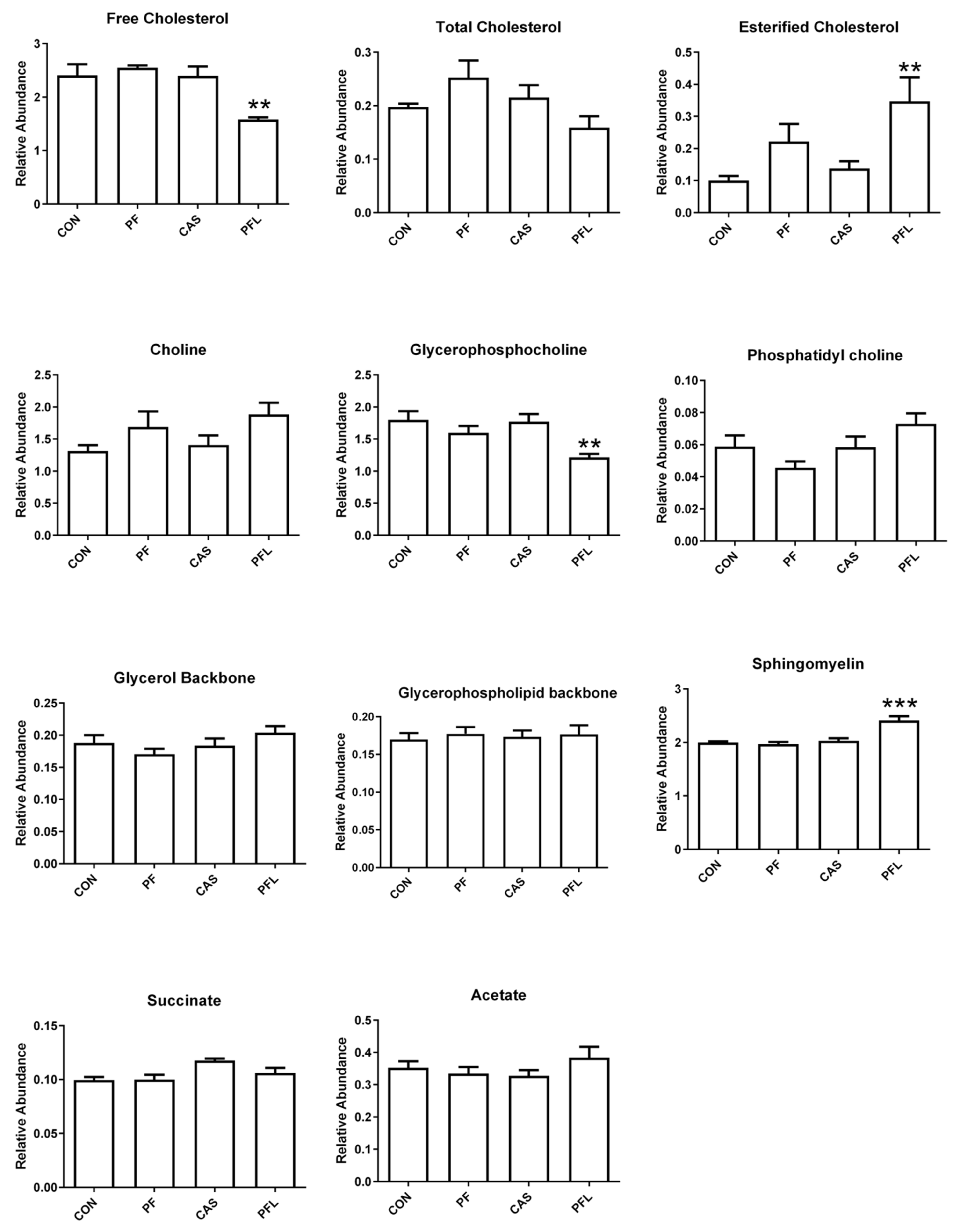
| RBF | Fatty Acids (% of Total FA) | ||||||||||
|---|---|---|---|---|---|---|---|---|---|---|---|
| C15:0 | C16:0 | C16:1n-9 | C18:0 | C18:1n-9 | C18:2n-6 | C18:3n-3 | Σ SFA | Σ MUFA | Σ PUFA | n-6:n-3 | |
| PF | 1.39 ± 0.27 | 72.98 ± 1.25 | 0.16 ± 0.30 | 5.16 ± 0.48 | 16.34 ± 0.46 | 3.40 ± 0.28 | 0.57 ± 0.37 | 79.53 ± 0.93 | 16.5 ± 0.67 | 3.97 ± 0.85 | 5.96 ± 0.81 |
| PFL | 1.15 ± 0.19 | 76.72 ± 0.69 | 0.05 ± 0.19 | 4.92 ± 0.48 | 12.85 ± 0.79 | 3.94 ± 0.31 | 0.37 ± 0.39 | 82.79 ± 0.86 | 12.90 ± 0.73 | 4.31 ± 0.87 | 10.65 ± 0.70 |
| CaS | 1.43 ± 0.15 | 48.31 ± 1.07 | 0.81 ± 0.29 | 4.33 ± 0.49 | 41.15 ± 0.43 | 1.64 ± 0.40 | 2.33 ± 0.27 | 54.07 ± 1.37 | 41.95 ± 0.37 | 3.97 ± 0.62 | 0.70 ± 0.15 |
| Diets | ||||
|---|---|---|---|---|
| Ingredients (%) | CON | PF | PFL | CaS |
| Soybean meal | 26 | 27 | 27 | 27 |
| Corn starch | 39 | 31 | 30 | 29 |
| Palm oil | 4 | 2 | 2 | 2 |
| Calcium carbonate | 1 | 1 | 1 | 1 |
| Vitamin-premix | 0.5 | 0.5 | 0.5 | 0.5 |
| NaCl | 0.5 | 0.5 | 0.5 | 0.5 |
| Prilled fat (RBFA) | - | 5 | - | - |
| Prilled fat with lecithin (RBFB) | - | - | 5 | - |
| Calcium soap (RBFC) | - | - | - | 5 |
| Rice straw (urea treated) | 29 | 33 | 34 | 35 |
| Total | 100 | 100 | 100 | 100 |
| Chemical composition (% DM) | ||||
| Dry Matter (DM) | 91.54 ± 0.98 | 92.08 ± 0.07 | 92.31 ± 0.23 | 91.95 ± 0.29 |
| Organic Matter (OM) | 93.29 ± 0.32 | 91.23 ± 1.82 | 91.31 ± 0.27 | 91.96 ± 0.54 |
| Crude Protein (CP) | 18.88 ± 0.49 | 18.57 ± 1.13 | 19.92 ± 3.16 | 19.23 ± 2.0 |
| Ether Extract (EE) | 4.98 ± 0.16 | 8.27 ± 0.41 | 8.04 ± 0.59 | 8.38 ± 0.40 |
| Acid Detergent Lignin (ADL) | 6.65 ± 1.32 | 13.33 ± 1.50 | 10.35 ± 3.85 | 4.92 ± 1.35 |
| Acid Detergent Fibre (ADF) | 17.89 ± 2.37 | 21.80 ± 0.94 | 24.33 ± 0.37 | 23.94 ± 2.17 |
| Neutral Detergent Fibre (NDF) | 56.06 ± 2.29 | 58.78 ± 2.73 | 60.22 ± 3.17 | 51.32 ± 2.62 |
| Crude Fibre (CF) | 12.67 ± 1.60 | 28.42 ± 3.07 | 30.09 ± 2.26 | 13.77 ± 2.60 |
| ME (MJ/kg DM) | 11.68 ± 0.20 | 11.65 ± 0.39 | 11.66 ± 0.18 | 11.68 ± 0.24 |
| Fatty acids (% of total FA) | ||||
| C15:0 | 0.78 ± 0.01 | 1.12 ± 0.03 | 0.95 ± 0.15 | 0.60 ± 0.19 |
| C16:0 | 32.93 ± 0.08 | 59.52 ± 1.10 | 61.49 ± 0.92 | 21.21 ± 0.77 |
| C16:1n-9 | 0.20 ± 0.01 | 0.13 ± 0.01 | 0.11 ± 0.01 | 0.30 ± 0.09 |
| C18:0 | 3.78 ± 0.09 | 4.87 ± 0.04 | 4.58 ± 0.01 | 2.62 ± 0.15 |
| C18:1n-9 | 42.38 ± 0.09 | 24.20 ± 0.53 | 21.83 ± 0.60 | 52.70 ± 0.75 |
| C18:2n-6 | 18.93 ± 0.10 | 9.69 ± 0.61 | 10.44 ± 0.32 | 21.51 ± 0.18 |
| C18:3n-3 | 1.00 ± 0.11 | 0.47 ± 0.03 | 0.60 ± 0.02 | 1.06 ± 0.09 |
| ΣSFA | 37.49 ± 0.09 | 65.51 ± 1.17 | 67.03 ± 0.91 | 24.43 ± 0.93 |
| Total Mono UFA | 42.58 ± 0.10 | 24.33 ± 0.53 | 21.94 ± 0.59 | 53.00 ± 0.75 |
| Total Poly UFA | 19.93 ± 0.10 | 10.16 ± 0.65 | 11.04 ± 0.33 | 22.56 ± 0.18 |
| n-6:n-3 | 18.93 ± 2.17 | 20.62 ± 0.02 | 17.40 ± 0.07 | 20.29 ± 0.21 |
| Treatments | p Value | ||||||
|---|---|---|---|---|---|---|---|
| Parameter | Aging Day | CON | PF | PFL | CaS | Diet | Diet × Day |
| pH | 0 | 5.87 ± 0.04 x | 5.88 ± 0.03 x | 5.89 ± 0.08 x | 5.84 ± 0.04 y | 0.273 | 0.012 |
| 1 | 5.80 ± 0.03 by | 5.80 ± 0.03 by | 5.81 ± 0.02 by | 5.87 ± 0.08 ay | 0.015 | ||
| 7 | 5.72 ± 0.10 z | 5.67 ± 0.04 z | 5.71 ± 0.03 z | 5.67 ± 0.04 x | 0.286 | ||
| p value | 0.001 | <0.0001 | <0.0001 | <0.0001 | |||
| Drip loss (%) | 1 | 1.75 ± 0.57 y | 2.30 ± 0.81 y | 1.65 ± 0.50 y | 1.56 ± 1.04 y | 0.282 | 0.555 |
| 7 | 2.82 ± 0.73 x | 3.52 ± 0.53 x | 3.50 ± 0.78 x | 3.25 ± 1.32 x | 0.445 | ||
| p value | 0.010 | 0.006 | 0.0002 | 0.021 | |||
| Cooking loss (%) | 0 | 32.05 ± 1.05 | 32.56 ± 0.18 xy | 32.21 ± 0.03 | 32.40 ± 0.02 y | 0.982 | 0.711 |
| 1 | 32.59 ± 1.22 | 33.39 ± 0.19 y | 34.54 ± 0.26 | 32.95 ± 0.22 y | 0.764 | ||
| 7 | 35.12 ± 0.33 | 35.19 ± 0.19 x | 36.67 ± 0.02 | 35.00 ± 0.05 x | 0.952 | ||
| p value | 0.112 | 0.014 | 0.051 | 0.024 | |||
| Shear force (kg) | 0 | 1.65 ± 0.24 x | 1.53 ± 0.24 | 1.60 ± 0.59 x | 1.54 ± 0.13 | 0.145 | 0.070 |
| 1 | 1.71 ± 1.61 a x | 1.63 ± 1.04 ab | 1.64 ± 1.14 ab x | 1.45 ± 1.3 b | 0.009 | ||
| 7 | 1.37 ± 0.23 y | 1.44 ± 0.23 | 1.34 ± 0.95 y | 1.49 ± 0.35 | 0.662 | ||
| p value | 0.008 | 0.083 | 0.0003 | 0.622 | |||
| Treatments | p Value | ||||||
|---|---|---|---|---|---|---|---|
| Parameter | Aging Day | CON | PF | PFL | CaS | Diet | Diet × Day |
| Lightness (L*) | 0 | 27.64 ± 3.80 xy | 26.73 ± 2.27 | 26.99 ± 2.55 y | 27.57 ± 2.84 | 0.810 | 0.055 |
| 1 | 25.86 ± 2.31 b y | 26.59 ± 2.37 b | 27.85 ± 2.95 ab y | 30.00 ± 4.51 a | 0.012 | ||
| 7 | 30.76 ± 5.23 x | 28.64 ± 3.86 | 31.24 ± 2.91 x | 28.93 ± 4.30 | 0.264 | ||
| p value | 0.013 | 0.130 | 0.001 | 0.276 | |||
| Redness (a*) | 0 | 8.32 ± 0.93 | 8.45 ± 1.62 | 8.97 ± 1.21 | 8.98 ± 1.64 | 0.422 | 0.784 |
| 1 | 8.05 ± 0.47 | 8.16 ± 0.96 | 8.90 ± 1.27 | 8.43 ± 0.81 | 0.080 | ||
| 7 | 7.95 ± 1.95 | 8.05 ± 1.78 | 8.21 ± 2.16 | 8.12 ± 1.47 | 0.957 | ||
| p value | 0.627 | 0.405 | 0.165 | 0.551 | |||
| Yellowness (b*) | 0 | 6.27 ± 099. y | 5.96 ± 1.29 | 6.24 ± 1.34 | 6.36 ± 1.21 | 0.838 | 0.048 |
| 1 | 5.86 ± 0.71 c y | 6.20 ± 0.77 bc | 6.86 ± 1.20 ab | 7.37 ± 0.91 a | 0.0003 | ||
| 7 | 7.39 ± 1.04 x | 6.44 ± 0.89 | 7.21 ± 1.74 | 6.77 ± 1.41 | 0.222 | ||
| p value | 0.0003 | 0.460 | 0.209 | 0.091 | |||
| b*/a* | 0 | 0.75 ± 0.09 y | 0.80 ± 0.05 xy | 0.78 ± 0.09 y | 0.80 ± 0.07 | 0.286 | 0.114 |
| 1 | 0.76 ± 0.09 c y | 0.86 ± 0.07 b y | 0.77 ± 0.09 c y | 0.89 ± 0.17 a | 0.003 | ||
| 7 | 1.08 ± 0.65 x | 0.90 ± 0.23 x | 0.95 ± 0.16 x | 0.87 ± 0.20 | 0.466 | ||
| p value | 0.004 | 0.049 | 0.0003 | 0.341 | |||
| Hue angle (H) | 0 | 36.85 ± 3.35 y | 38.67 ± 1.74 | 37.75 ± 3.35 y | 38.68 ± 2.46 | 0.268 | 0.065 |
| 1 | 36.90 ± 3.36 ab y | 39.25 ± 2.62 b | 38.50 ± 3.11 ab y | 40.12 ± 5.06 a | 0.004 | ||
| 7 | 43.75 ± 5.64 x | 41.18 ± 6.58 | 43.10 ± 4.58 x | 40.38 ± 6.24 | 0.586 | ||
| p value | 0.007 | 0.055 | 0.0003 | 0.403 | |||
| Chroma (C*) | 0 | 9.43 ± 0.22 y | 9.54 ± 0.10 | 10.13 ± 0.17 | 10.21 ± 0.15 | 0.591 | 0.402 |
| 1 | 9.97 ± 0.22 c xy | 10.26 ± 0.16 b | 10.25 ± 0.17 a | 11.24 ± 0.25 a | 0.004 | ||
| 7 | 10.95 ± 0.41 x | 10.97 ± 0.32 | 10.66 ± 0.23 | 11.47 ± 0.31 | 0.566 | ||
| p value | 0.045 | 0.529 | 0.363 | 0.209 | |||
| Treatments | ||||||
|---|---|---|---|---|---|---|
| Parameter | CON | PF | PFL | CaS | SEM | p Value |
| C12:0 | 1.32 ± 0.26 | 1.10 ± 0.24 | 0.94 ± 0.18 | 1.08 ± 0.35 | 0.054 | 0.080 |
| C14:0 | 1.70 ± 0.28 a | 1.44 ± 0.31 ab | 1.20 ± 0.25 b | 1.48 ± 0.33 ab | 0.063 | 0.035 |
| C15:0 | 1.62 ± 0.19 a | 1.36 ± 0.32 ab | 1.12 ± 0.10 b | 1.28 ± 0.46 ab | 0.064 | 0.036 |
| C16:0 | 20.40 ± 0.59 | 19.64 ± 0.54 | 19.53 ± 0.51 | 19.97 ± 0.80 | 0.128 | 0.062 |
| C16:1n-7 | 0.67 ± 0.19 b | 0.93 ± 0.19 b | 1.26 ± 0.23 a | 0.90 ± 0.31 b | 0.058 | 0.001 |
| C17:0 | 2.11 ± 0.43 | 1.98 ± 0.31 | 1.82 ± 0.38 | 1.86 ± 0.36 | 0.070 | 0.485 |
| C18:0 | 23.09 ± 0.60 | 23.21 ± 0.61 | 23.23 ± 0.51 | 23.25 ± 0.78 | 0.113 | 0.962 |
| C18:1n-9 | 36.09 ± 0.53 b | 36.62 ± 0.81 ab | 37.16 ± 0.50 a | 36.36 ± 0.62 b | 0.135 | 0.026 |
| C18:1 trans-11 | 1.87 ± 0.30 b | 2.01 ± 0.28 b | 2.35 ± 0.19 a | 2.05 ± 0.38 ab | 0.063 | 0.039 |
| CLA Cis-9 Trans-11 | 0.99 ± 0.25 | 0.84 ± 0.25 | 0.93 ± 0.27 | 0.92 ± 0.19 | 0.045 | 0.723 |
| CLA Trans-10 Cis-12 | 0.62 ± 0.14 | 0.68 ± 0.21 | 0.70 ± 0.12 | 0.72 ± 0.17 | 0.030 | 0.646 |
| C18:2n-6 | 5.03 ± 0.29 b | 5.15 ± 0.26 b | 5.71 ± 0.40 a | 5.14 ± 0.47 b | 0.082 | 0.008 |
| C18:3n-3 | 0.60 ± 0.16 b | 0.71 ± 0.11 ab | 0.84 ± 0.10 a | 0.75 ± 0.14 ab | 0.028 | 0.019 |
| C20:4n-6 | 2.07 ± 0.41 | 2.24 ± 0.30 | 2.29 ± 0.49 | 2.21 ± 0.26 | 0.069 | 0.711 |
| C20:5n-3 | 0.32 ± 0.12 | 0.34 ± 0.15 | 0.26 ± 0.15 | 0.29 ± 0.11 | 0.024 | 0.689 |
| C22:5n-3 | 0.36 ± 0.24 | 0.58 ± 0.29 | 0.47 ± 0.29 | 0.57 ± 0.25 | 0.051 | 0.400 |
| C22:6n-3 | 1.15 ± 0.13 | 1.17 ± 0.25 | 1.19 ± 0.25 | 1.17 ± 0.34 | 0.045 | 0.986 |
| Sums and ratios | ||||||
| ∑SFA | 50.24 ± 0.41 a | 48.72 ± 0.62 b | 47.84 ± 0.62 b | 48.91 ± 1.63 b | 0.236 | 0.001 |
| ∑UFA | 49.77 ± 0.98 c | 51.28 ± 0.45 b | 53.16 ± 0.83 a | 51.08 ± 1.50 b | 0.295 | <0.0001 |
| ∑MUFA | 38.64 ± 0.69 c | 39.56 ± 0.68 b | 40.77 ± 0.41 a | 39.32 ± 0.68 bc | 0.186 | <0.0001 |
| ∑PUFA | 11.13 ± 0.65 b | 11.72 ± 0.39 ab | 12.39 ± 0.79 a | 11.77 ± 0.90 ab | 0.153 | 0.024 |
| ∑n-3 | 2.43 ± 0.36 | 2.80 ± 0.44 | 2.77 ± 0.57 | 2.77 ± 0.54 | 0.092 | 0.431 |
| ∑n-6 | 7.09 ± 0.43 b | 7.39 ± 0.36 b | 8.00 ± 0.58 a | 7.36 ± 0.57 b | 0.108 | 0.016 |
| n-6:n-3 | 2.98 ± 0.48 | 2.70 ± 0.52 | 3.01 ± 0.72 | 2.74 ± 0.57 | 0.107 | 0.668 |
| UFA:SFA | 0.99 ± 0.02 c | 1.05 ± 0.02 b | 1.11 ± 0.02 a | 1.05 ± 0.05 b | 0.010 | <0.0001 |
| PUFA:SFA | 0.22 ± 0.02 c | 0.24 ± 0.01 b | 0.26 ± 0.01 a | 0.24 ± 0.02 b | 0.004 | 0.001 |
| Treatments | ||||||
|---|---|---|---|---|---|---|
| Parameter | CON | PF | PFL | CaS | SEM | p Value |
| C12:0 | 0.52 ± 0.37 | 0.38 ± 0.29 | 0.36 ± 0.20 | 0.47 ± 0.35 | 0.056 | 0.744 |
| C14:0 | 0.83 ± 0.12 | 0.81 ± 0.14 | 0.76 ± 0.18 | 0.75 ± 0.15 | 0.027 | 0.723 |
| C15:0 | 0.66 ± 0.41 | 0.38 ± 0.21 | 0.46 ± 0.24 | 0.49 ± 0.35 | 0.059 | 0.394 |
| C16:0 | 15.98 ± 0.99 | 15.53 ± 1.13 | 15.75 ± 0.47 | 15.31 ± 0.64 | 0.159 | 0.502 |
| C16:1n-7 | 1.14 ± 0.34 | 1.07 ± 0.37 | 1.02 ± 0.28 | 1.09 ± 0.25 | 0.056 | 0.914 |
| C17:0 | 2.23 ± 0.31 | 2.09 ± 0.29 | 2.19 ± 0.34 | 2.10 ± 0.43 | 0.062 | 0.838 |
| C18:0 | 30.18 ± 0.56 | 29.82 ± 0.53 | 30.06 ± 0.29 | 30.17 ± 0.86 | 0.110 | 0.660 |
| C18:1n-9 | 22.63 ± 0.59 | 22.84 ± 0.93 | 23.13 ± 0.70 | 22.66 ± 0.83 | 0.144 | 0.613 |
| C18:1 trans-11 | 2.61 ± 0.57 | 2.90 ± 0.33 | 2.95 ± 0.27 | 3.10 ± 0.67 | 0.093 | 0.324 |
| CLA Cis-9 Trans-11 | 1.08 ± 0.45 | 1.10 ± 0.25 | 1.01 ± 0.33 | 1.14 ± 0.22 | 0.058 | 0.890 |
| CLA Trans-10 Cis-12 | 0.62 ± 0.50 b | 1.18 ± 0.31 a | 1.19 ± 0.29 a | 1.37 ± 0.25 a | 0.083 | 0.003 |
| C18:2n-6 | 9.00 ± 0.33 | 9.15 ± 0.39 | 9.26 ± 0.48 | 9.16 ± 0.35 | 0.072 | 0.675 |
| C18:3n-3 | 0.79 ± 0.09 | 0.80 ± 0.13 | 0.82 ± 0.15 | 0.83 ± 0.14 | 0.023 | 0.941 |
| C20:4n-6 | 6.04 ± 0.33 | 6.31 ± 0.18 | 6.10 ± 0.46 | 6.01 ± 0.26 | 0.062 | 0.316 |
| C20:5n-3 | 3.29 ± 0.30 | 3.31 ± 0.65 | 3.40 ± 0.39 | 3.07 ± 0.35 | 0.082 | 0.546 |
| C22:5n-3 | 0.94 ± 0.17 | 1.05 ± 0.26 | 0.85 ± 0.26 | 1.06 ± 0.30 | 0.048 | 0.385 |
| C22:6n-3 | 1.48 ± 0.18 a | 1.29 ± 0.25 a | 0.68 ± 0.24 b | 1.24 ± 0.24 a | 0.070 | <0.0001 |
| Sums and ratios | ||||||
| ∑SFA | 50.39 ± 1.55 | 49.00 ± 1.24 | 49.58 ± 0.74 | 49.28 ± 1.76 | 0.265 | 0.291 |
| ∑UFA | 49.61 ± 1.42 | 50.99 ± 1.67 | 50.42 ± 1.77 | 50.71 ± 1.16 | 0.289 | 0.383 |
| ∑MUFA | 26.38 ± 1.13 | 26.81 ± 1.01 | 27.10 ± 0.70 | 26.85 ± 1.22 | 0.190 | 0.631 |
| ∑PUFA | 23.23 ± 0.66 | 24.19 ± 0.96 | 23.32 ± 1.37 | 23.87 ± 0.61 | 0.185 | 0.213 |
| ∑n-3 | 6.50 ± 0.36 | 6.46 ± 0.83 | 5.76 ± 0.71 | 6.20 ± 0.57 | 0.128 | 0.152 |
| ∑n-6 | 15.04 ± 0.47 | 15.46 ± 0.48 | 15.36 ± 0.69 | 15.17 ± 0.55 | 0.103 | 0.494 |
| n-6:n-3 | 2.32 ± 0.12 b | 2.43 ± 0.34 ab | 2.70 ± 0.33 a | 2.47 ± 0.32 ab | 0.058 | 0.129 |
| UFA:SFA | 0.99 ± 0.05 b | 1.04 ± 0.05 a | 1.02 ± 0.02 ab | 1.03 ± 0.04 ab | 0.009 | 0.138 |
| PUFA:SFA | 0.46 ± 0.02 b | 0.49 ± 0.03 a | 0.47 ± 0.02 ab | 0.48 ± 0.02 ab | 0.005 | 0.065 |
Publisher’s Note: MDPI stays neutral with regard to jurisdictional claims in published maps and institutional affiliations. |
© 2021 by the authors. Licensee MDPI, Basel, Switzerland. This article is an open access article distributed under the terms and conditions of the Creative Commons Attribution (CC BY) license (https://creativecommons.org/licenses/by/4.0/).
Share and Cite
Behan, A.A.; Akhtar, M.T.; Loh, T.C.; Fakurazi, S.; Kaka, U.; Muhamad, A.; Samsudin, A.A. Meat Quality, Fatty Acid Content and NMR Metabolic Profile of Dorper Sheep Supplemented with Bypass Fats. Foods 2021, 10, 1133. https://doi.org/10.3390/foods10051133
Behan AA, Akhtar MT, Loh TC, Fakurazi S, Kaka U, Muhamad A, Samsudin AA. Meat Quality, Fatty Acid Content and NMR Metabolic Profile of Dorper Sheep Supplemented with Bypass Fats. Foods. 2021; 10(5):1133. https://doi.org/10.3390/foods10051133
Chicago/Turabian StyleBehan, Atique Ahmed, Muhammad Tayyab Akhtar, Teck Chwen Loh, Sharida Fakurazi, Ubedullah Kaka, Azira Muhamad, and Anjas Asmara Samsudin. 2021. "Meat Quality, Fatty Acid Content and NMR Metabolic Profile of Dorper Sheep Supplemented with Bypass Fats" Foods 10, no. 5: 1133. https://doi.org/10.3390/foods10051133
APA StyleBehan, A. A., Akhtar, M. T., Loh, T. C., Fakurazi, S., Kaka, U., Muhamad, A., & Samsudin, A. A. (2021). Meat Quality, Fatty Acid Content and NMR Metabolic Profile of Dorper Sheep Supplemented with Bypass Fats. Foods, 10(5), 1133. https://doi.org/10.3390/foods10051133







